Via MD DNR:
By: Keith Lockwood
Today, April 21, is a big day for those who dream of catching a trophy striped bass. More than a few anglers will spend the night before checking alarm clocks just to find themselves waking up a half-hour before the alarm is set to go off anyhow.
Weather is predicted to be a little nippy in the morning but should warm up as the day progresses. It will be a wonderful day to be out on the water with family and friends.
Before we get into this week’s fishing report, I want to remind everyone that they can submit their own fishing reports and photos to the Maryland Angler’s Log. To post a report, please email your name, hometown, photos, location and additional content for your report. All information is optional, but encouraged.
The striped bass spawning in the Choptank, Nanticoke, Patuxent and Potomac rivers is behind schedule due to colder than expected water temperatures, and spawning in the upper Chesapeake Bay is most likely weeks away. This week the spawning area in the Choptank River registered 56 degrees and there is a minor amount of spawning occurring. Usually spawning begins at 60 degrees and is optimal at 64.5 degrees, so many female striped bass are still holding in the spawning reaches. Based on predicted weather forecasts, it may be another week or so for water temperatures to be correct in that area.
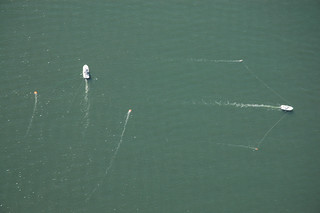
This photo taken from a helicopter shows planer board trolling gear deployed, a situation you do not want to find yourself in when trolling. Photo by Keith Lockwood
Those out trolling Saturday will most likely be kept busy clearing lines of winter jellies which are being swept along the steep channel edges. Unfortunately these are the same locations where the most optimum trolling will take place for striped bass. Winter jellies are actually lion’s mane jellyfish which are moving down the bay as part of their life cycle.
Pre-spawn striped bass will be the most common large fish being caught and it will be a tough decision for some to keep these fish or release them. The minimum size for striped bass during the trophy season is 35 inches. Chartreuse and white bucktails and parachutes in 2-6 ounce sizes will be the most common lures used and will be set to cover a wide variety of depths when searching for fish. Trolling speeds are often about 3 knots and the trolling pattern is perpendicular to the shipping channel edges.
Weekly Fishing Conditions Forecast Summary: April 17 – 24, 2018
Expect an unstable, windy weather pattern through Friday with warming weather for rest of the next week. These slowly warming temperatures will help heat bay waters for rockfish, shad and other fish preparing to spawn here in the next several weeks. Temperatures on the Susquehanna Flats are hovering just shy of 50 degrees but climbing for start of the trophy rockfish season. Warming temperatures are also a cue for blue crabs to emerge from their winter slumber in the bay’s deeper areas.
Maryland’s portion of the bay continues to have suitable oxygen conditions from surface to bottom. In addition, there are slightly warmer surface water temperatures so anglers may want to scan these shallower areas for fish during moving water and low light conditions after sunset and before sunrise.
As reported by the National Oceanic and Atmospheric Administration buoys, main bay surface water temperatures are holding about 51 degrees at the Annapolis, Gooses Reef and Point Lookout buoys. Expect temperatures in smaller, dark-bottomed shallow creeks to hold slightly warmer temperatures. As tides empty the water in these warm creeks, look for nearby structure to target feeding gamefish. Expect average flows for the Susquehanna River, with above average flows for the Potomac and for smaller rivers and streams entering the bay. There will be above average tidal currents through Saturday as a result of the new moon this past Monday.
For the full weekly fishing conditions summary and more detailed and up-to-date fishing conditions in your area of the bay, be sure to check out Eyes on the Bay’s Click Before You Cast.
Upper Chesapeake Bay
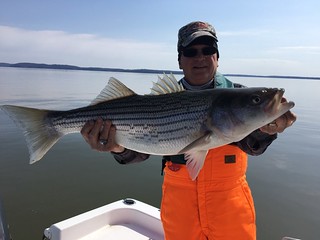
Jimmy Sargent spent a fine day on the flats casting jigs and managed to quickly catch and release this fine-looking fish. Photo by Herb Floyd
The hickory shad have arrived in the lower river and are staging for their spawning run up Deer Creek. A few have been caught in the river but the best is yet to come when we get some warm weather. The creek’s water temperature is also running cold and needs to warm up before the spawning runs start in earnest. The hickory shad will start to run when water temperatures are in the low 50s with a peak occurring from 59 to 72 degrees. It can be a tricky affair to be on scene since the hickory shad tend to run in pulses up Deer Creek to spawn since cold snaps, rain events and warm sunny weather all have an effect on water temperatures. There is a smaller run of hickory shad at Octoraro Creek and often the water is a bit warmer than Deer Creek, so a spawning run can occur at Octoraro first.
Cold water temperatures in the Susquehanna Flats are also holding back the striped bass spawn area and the arrival of the larger females. Casting jigs this week can often result in double-digit numbers of small male striped bass in the 16 to 29-inch size range a larger female once in a while. If one is careful this is a great area to fish from a kayak; casting is easy and if you have a rod holder you can even troll a line. The best catches of large pre-spawn female striped bass are occurring by slow trolling with large diving plugs in the 8 to 10-inch size range. When fishing this way, anglers must remember to remove the barbs on the treble hooks, or better yet replace them with single hooks that have the barbs removed. Anglers are reminded that fish are to be released quickly.
There has been a limited amount of catch-and-release fishing for striped bass in the upper bay region along channel edges and the Bay Bridge. Some anglers are jigging along channel edges when they can find suspended fish holding. Most of these fish are smaller striped bass in the 19 to 28-inch size range. The same is being said for the Bay Bridge piers and rock piles. Water temperatures have slowly climbed to 50 degrees. Trolling along channel edges has resulted in a few large fish being caught and released but the action is being reported as very slow.
Middle Bay
Boats have been leaving ports to stretch their legs – so to speak – throughout the middle bay region. Windy conditions have made it tough to be out on the open waters of the bay (remember to always wear your life jacket), but there have been a few days when the winds were moderate. Trolling along the steep shipping channel edges at Bloody Point south to Buoy R 84 and near the CP Buoy have been good places this past week for catch–and-release fishing. The Calvert Cliffs Nuclear Power Plant warm water discharge continues to be the place to jig for large female striped bass. Large soft plastic jigs tend to be the ticket to this show while drifting in the warm effluent current. All of these large female fish are of course pre-spawn and most likely on their way to the upper bay spawning site, so they need to be handled with great care.
The white perch spawning runs are still underway in the major tidal rivers and can provide some fun fishing and table fare. The white perch are still spread from the Greensboro area up to the Red Bridges gauging station in the upper Choptank River. The river has been high over its banks due the big rain we received this past Sunday night, but has returned to normal conditions. The hickory shad are present in the same areas and both white perch and hickory shad can be caught on shad darts. When the post-spawn white perch begin to retreat down river, fishing with bloodworms in the deeper holes is a good tactic.
Lower Bay
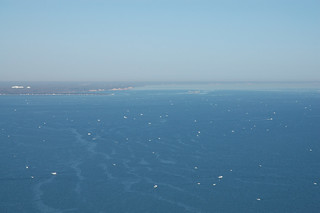
This aerial photo of boats on Opening Day a few years ago gives an idea how many people will be out there Saturday. Photo by Keith Lockwood
Catch-and-release fishing for large striped bass in the lower bay is being reported to be slow this week along the shipping channel edges. A few smaller striped bass are being caught and released by jigging along the bay’s channel edges and the middle Potomac River’s channels. Opening Day will see a lot of boats trying their luck out on the bay, and the Cove Point area is a traditional area to troll.
Fishing for white perch continues to be very good in the Nanticoke, Wicomico and Pocomoke rivers. Many of the larger white perch are beginning to make their way down river from the spawning areas. Fishing with pieces of bloodworms on bottom rigs in some of the deeper waters is a good bet. Fishing for channel and blue catfish has also been very good in the Nanticoke River.
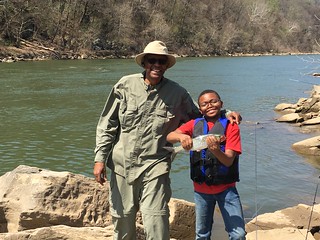
These two buddies, “Big and Little” Chuck Vinson, had a wonderful time fishing for hickory shad in the upper tidal Potomac recently. Photo courtesy of Chuck Vinson
Catch-and-release fishing for hickory shad is about as good as it gets in the tidal Potomac near the Chain Bridge in the District of Columbia. Your Maryland license will not be valid there but the cost of a nonresident license is worth the fun of catching hickory and American shad. There is a boat livery there to rent rowboats, and there is plenty of shoreline access. This is a wonderful place to take a fly rod and enjoy the action. Small shiny spoons, shad darts and brightly colored and weighted flies work well for this catch and release action.
Freshwater Fishing
Walleye season is now open at Deep Creek Lake and the upper Potomac, and although the river is not safe for fishing at the moment due to high flows, the lake is ready. The walleye at Deep Creek Lake can be found along rocky shoals in the evenings, and along steep rocky shoreline edges. Casting jerkbaits is a fun way to fish for them as is using minnows and drifting them with a couple of split shot down deep. Largemouth bass are moving into shallower areas near fallen treetops and sunken wood. Small crankbaits that imitate crayfish is a good bet in the transition areas where it is a little deeper, while jerkbaits and lipless crankbaits work well in the shallower areas. Crappie can be found around bridge piers in deeper water and bluegills in the shallower areas of grassy coves. Rocky flats near points can be good places to look for smallmouth bass.
The spring trout season continues to be a winner this week as stocking crews are busy with supplemental stockings at a trout management water near you. Except for some recent heavy rain in the central region and some snow in the western region, flow conditions have generally been good. Temperatures will moderate this week so don’t miss the action. I stopped by the Albert Powell State Fish Hatchery just south of Hagerstown last week and the staff there was busy as ever moving trout out on trucks and taking care of the trout in the raceways. One thing I noticed was there are a lot of trout still in some of the raceways ready to be stocked — and some were the size and type of any trout fisherman’s dreams.
In many of the trout management waters that are set aside for fly-fishing or catch-and-release there continues to be wonderful opportunities. Fly-fishermen are doing well using deer hair type dry flies or floating caddis with a bead head nymph dropper. Another combination that is working well is a tandem nymph rig with a strike indicator. The Hunting Creek and Little Hunting Creek special management areas are fishing well with small blue-winged olives and black caddis and a few stone flies hatching. If nothing is rising try using a small pheasant tail nymph. In the areas set aside for artificials-only, those using spinning gear can do well with small spinners.
Crappie fishing continues to be excellent this week as the larger female fish are schooling up near deep structure. Good crappie fishing can be found near docks, fallen treetops and bridge piers at Liberty Reservoir, Loch Raven Reservoir, Piney Run Reservoir and many of the smaller lakes and ponds that dot the Maryland landscape. Tidal rivers such as the Potomac, Patuxent, Nanticoke, Pocomoke and Choptank also offer good crappie fishing near structure. It is hard to beat a small minnow under a slip bobber but small jigs can work well also.
Largemouth bass are systematically moving from their deeper winter haunts toward shallower and warmer areas. The small males are closer to or in the shallower areas and the larger females tend to be a little deeper in transition areas depending on water temperatures. Both males and females are binge feeding to build up lost body mass and females are finishing off the eggs they are carrying. Small crankbaits that resemble crayfish are a good bet in the deeper transition zones. Jerkbaits work well in the shallower areas of the transition zones and small lipless crankbaits a good tactic in the shallow areas.
Last but not least fishing for catfish should not be overlooked this week. The tidal rivers have excellent populations of channel catfish. The tidal Potomac River is loaded with blue catfish and to a lesser degree in the Nanticoke River. Flathead catfish can be found in the lower Susquehanna River up to the Conowingo Dam pool.
Atlantic Ocean and Coastal Bays
At the present time water temperatures near Ocean City are about 47 degrees and slightly warmer out in the deeper waters. Tautog fishing remains good at the nearshore wreck and reef sites and some nice size ones are being caught on green crabs.
Schools of menhaden can be seen moving north along the beaches and being pestered by diving gannets. There has been talk of a few medium-sized bluefish being caught but the big racers or large thin bluefish have not been reported yet along the beaches. In the back bay areas the first flounder has been caught inside the Ocean City Inlet and there has been some catch and release action on small striped bass around the Route 90 Bridge.
Boom...Morgan
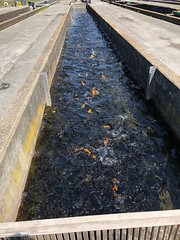
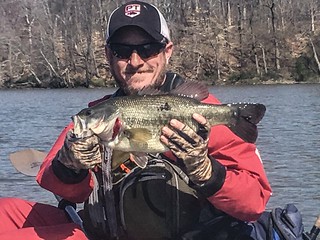
No comments:
Post a Comment